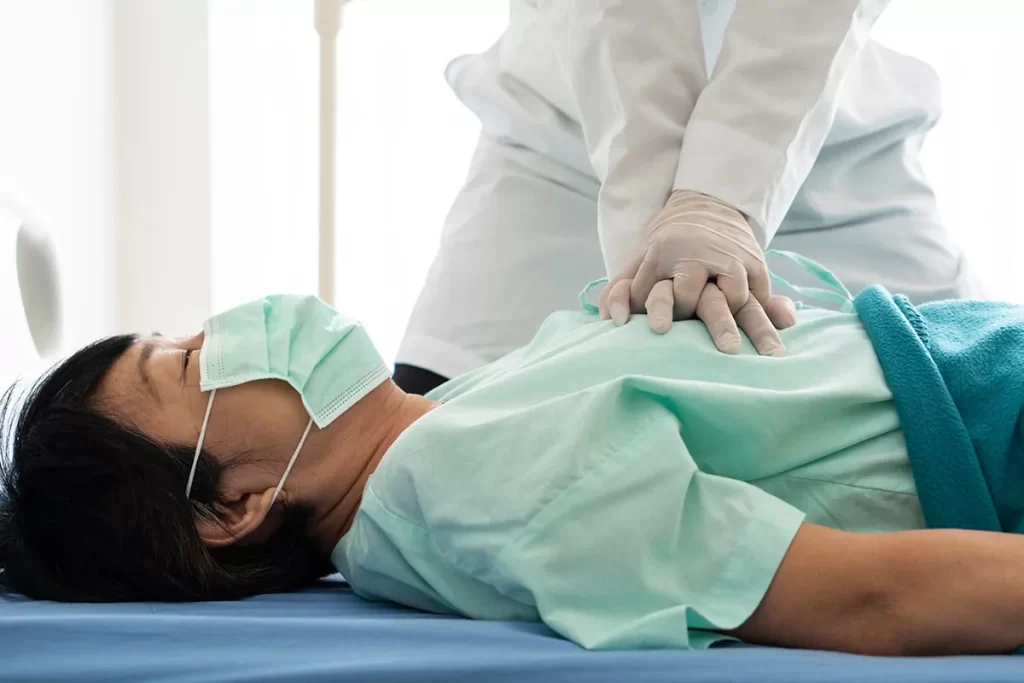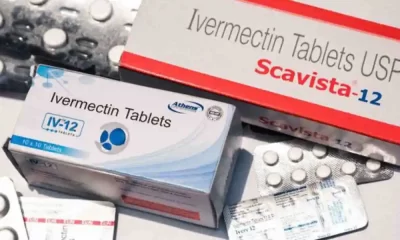Health
What is CPR?

Cardiopulmonary Resuscitation (CPR) is a vital life-saving method that plays a critical role in emergency scenarios where an individual’s heart has ceased functioning or they have ceased to breathe.
It involves a series of actions aimed at restoring the flow of oxygenated blood to the brain and vital organs, increasing the chances of survival until professional medical help arrives. In this article, we will explore the importance of BLS/CPR, its main techniques, and its impact on saving lives.
Components of Cardiopulmonary Resuscitation
- Chest compressions: Applying pressure to the center of the individual’s chest using the palm of your hand is a crucial part of performing cardiopulmonary resuscitation (CPR). The objective is to exert firm downward force, reaching a depth of at least 2 inches (5 centimeters) and maintaining a rhythm of 100-120 compressions per minute. These compressions serve the purpose of manually stimulating the heart, facilitating the circulation of blood to critical organs.
- Rescue breaths: Rescue breaths, also known as mouth-to-mouth ventilation, involve providing breaths to the victim to restore oxygen exchange in the lungs. Following 30 chest compressions, incline the individual’s head slightly backward and elevate their chin to unblock the air passage. Seal the victim’s nostrils by pinching them together, cover their mouth with yours, and administer two gentle breaths. Each breath should endure approximately one second and result in noticeable expansion of the chest..
- Airway management: Ensuring an open airway is essential during CPR. Before delivering rescue breaths, check for any obstructions such as foreign objects, vomit, or the victim’s tongue blocking the airway. If an obstruction is present, gently remove it using your fingers or by tilting the head back and sweeping the mouth with your fingers.
- Early defibrillation: If there is access to an automated external defibrillator (AED), it is crucial to utilize it promptly. AEDs administer an electrical impulse to the heart, reinstating its regular rhythm when encountering cardiac arrest due to specific forms of arrhythmias. Follow the AEDs voice prompts and adhere to the recommended steps for safe and effective defibrillation.

Cardiopulmonary Resuscitation for Special Populations
Cardiopulmonary Resuscitation for Special Populations refers to adaptations and modifications in cardiopulmonary resuscitation techniques to cater to individuals with specific needs or conditions. Here is an enumeration and explanation of Cardiopulmonary Resuscitation For various special populations:
- Persons with Disabilities: A program has been developed to empower people with disabilities to advise others on performing Cardiopulmonary Resuscitation and using automated external defibrillators (AEDs). This program aims to ensure that individuals with disabilities can actively contribute to saving lives in emergency situations.
- Pregnant Individuals: When performing Cardiopulmonary Resuscitation on a pregnant person, the technique remains similar to standard Cardiopulmonary Resuscitation. However, the rescuer should position their hands slightly higher on the chest to avoid pressure on the abdomen. It is essential to ensure continuous high-quality chest compressions and appropriate airway management.
- Obese Individuals: For individuals with obesity, the rescuer may need to use more force during chest compressions due to the increased body mass. Maintaining a proper hand placement and depth of compressions is crucial to provide effective circulation.
- Patients with Comorbidities: Particular attention must be given when administering Cardiopulmonary Resuscitation to individuals with significant concurrent medical conditions, such as asthma or heart failure with ventricular assist devices. Cardiopulmonary Resuscitation guidelines specific to these conditions should be followed to maximize the chances of successful resuscitation.
- Children with Special Needs: Cardiopulmonary Resuscitation techniques for children with special needs do not differ significantly from standard Cardiopulmonary Resuscitation. However, it is essential to adapt the approach based on the child’s individual condition and needs. Caregivers and medical professionals need to be trained to provide CPR and first aid to children with special needs effectively.
- Underserved Populations: Bystander Cardiopulmonary Resuscitation occurs less frequently in underserved communities, leading to lower survival rates. Efforts have been made to provide CPR training specifically targeted towards underserved populations to increase their knowledge and ability to respond during emergencies.
Adapting Cardiopulmonary Resuscitation Techniques for special populations emphasizes the importance of inclusivity and ensuring that everyone, regardless of their physical or medical condition, receives the necessary care during cardiac emergencies. Proper training and certification programs specific to these populations have been developed to equip individuals with the skills needed to provide effective Cardiopulmonary Resuscitation.

Components of Post-Cardiac CPR Arrest Care
Post-cardiac arrest care refers to the comprehensive medical treatment and interventions provided to individuals who have experienced a cardiac arrest and successfully regained spontaneous circulation.
- Immediate assessment and stabilization: After successful resuscitation, the individual’s vital signs, level of consciousness, and oxygenation are closely monitored. Any ongoing interventions, such as mechanical ventilation or medication administration, are continued or adjusted as necessary.
- Targeted temperature management (TTM): TTM, also known as therapeutic hypothermia or targeted hypothermia, is a key component of post-cardiac arrest care. It involves lowering the patient’s body temperature to a specific target range (usually around 32-36°C or 89.6-96.8°F) for a defined period (usually 24-48 hours). TTM has been shown to improve neurological outcomes and decrease brain damage following cardiac arrest.
- Coronary angiography and revascularization: When cardiac arrest is a result of a heart attack due to blocked coronary arteries, doctors may conduct coronary angiography to assess the extent of artery disease. If significant blockages are identified, procedures like percutaneous coronary intervention (PCI) or coronary artery bypass grafting (CABG) can be performed to restore blood flow and decrease the chances of future cardiac incidents.
- Hemodynamic optimization: The patient’s hemodynamic stability is carefully managed to optimize cardiac function and perfusion. To bolster blood pressure and cardiac output, medicines such as vasoconstrictors or positive inotropic agents may be given. Fluid resuscitation is guided by careful monitoring of central venous pressure, arterial blood pressure, and other parameters.
- Oxygenation and respiratory support: Adequate oxygenation and ventilation are crucial during post-cardiac arrest care. Mechanical ventilation may be continued or adjusted as needed to maintain appropriate oxygen levels and respiratory function. Blood gasses and other parameters are closely monitored to guide treatment.
- Neurological monitoring and management: Continuous neurological monitoring is performed to assess brain function and detect any signs of neurologic injury. Additional interventions, such as seizure prophylaxis or treatment, may be initiated if necessary. Neurological assessments, including neuroimaging studies, may also be conducted to evaluate brain damage or other abnormalities.
- Supportive care and rehabilitation: Providing emotional assistance, psychosocial interventions, and engaging families are crucial elements of post-cardiac arrest treatment. Rehabilitation, which encompasses physical therapy, occupational therapy, and speech therapy, may be initiated to facilitate functional recuperation and enhance long-term results.
Health
Report Causes Pfizer Stock to Climb Approximately $1 Billion Acquired by Starboard

(VOR News) – According to a rumor that activist investor Pfizer Starboard Value has taken a holding in the struggling pharmaceutical business that is expected to be worth around one billion dollars, the stock of Pfizer (PFE) is on the increase in premarket trading on Monday.
This comes after the report was made public. The report was made available to the general public following this. Starboard Value was successful in moving forward with the acquisition of the position.
Starboard is said to have approached Ian Read, a former chief executive officer of Pfizer, and Frank D’Amelio, a former chief financial officer, in order to seek assistance with its goals of boosting the performance of the company, according to the Wall Street Journal. Read and D’Amelio are both former Pfizer executives.
The purpose of this is to facilitate the accomplishment of its objectives, which include enhancing the overall performance of the firm.
In their previous jobs, D’Amelio and Read were chief financial officers.
It is stated in the report that the hedge fund is of the opinion that Pfizer, which is currently being managed by Albert Bourla, who succeeded Read as Chief Executive Officer (CEO) in 2019, does not demonstrate the same level of mergers and acquisitions (M&A) discipline that Read did. Bourla took over for Read in 2019. Read was succeeded by Bourla in the year 2019.
Pfizer, a multinational pharmaceutical conglomerate, has made substantial investments in the acquisition of more companies that are involved in the research and development of cancer medicines.
These businesses have been acquired for billions of dollars. The biotechnology company Seagen, which was acquired by Pfizer in the previous year for a price of $43 billion, is included in this category. One of the businesses that can be classified as belonging to this category is Seagen.
In spite of the fact that the S&P 500 Index experienced a 21% increase in 2024.
No major trading occurred in Pfizer stock that year.
Due to the fact that the demand for Pfizer’s COVID-19 vaccines fell after the firm reached its pandemic peak in 2021, the share price of the corporation has decreased by over fifty percent since that time.
This drop has occurred ever since the company’s shares reached their maximum peak, which was during the time that this decline occurred. Not only have they not changed at all, but they have also remained essentially stable. This is in contrast to the S&P 500, which has gained 21% since the beginning of this year.
Recently, the corporation was forced to take a hit when it decided to recall all of the sickle cell illness medications that it had distributed all over the world.
Fears that the prescription could lead patients to experience severe agony and possibly even death were the impetus for the decision to recall the product. In spite of the fact that Pfizer’s stock is increasing by almost three percent as a result of the news that followed the company’s decision, this is the circumstance that has come about.
SOURCE: IPN
SEE ALSO:
New Study Reveals Drinking Soda Pop Increases the Risk of Stroke
The Mpox Vaccine’s Protection Decreases Within a Year; Booster Requirements
Health
New Study Reveals Drinking Soda Pop Increases the Risk of Stroke

A recent report from global research indicates that excessive consumption of coffee or soda pop is associated with an increased risk of stroke, although the intake of black and green tea is correlated with a reduced risk. Excessive consumption of soda pop or coffee warrants caution!
Recent research indicates that it may substantially elevate the risk of stroke.
Consuming four cups of coffee daily elevates the risk of stroke, according to studies, although ingesting 3-4 cups of black or green tea daily typically offers protection against stroke. Additionally, consume more coffee; it may reduce your risk of mortality.
Recent findings from global research studies co-led by the University of Galway and McMaster University, alongside an international consortium of stroke researchers, indicate that soda, encompassing both sugar-sweetened and artificially sweetened variants such as diet or zero sugar, is associated with a 22 percent heightened risk of stroke. The risk escalated significantly with the consumption of two or more of these beverages daily.
Stroke Risk Fizzy Drinks and Soda Pop
The correlation between fizzy drinks consumption and stroke risk was most pronounced in Europe, the Middle East, Africa, and South America. Women exhibit the most elevated risk of stroke from bleeding (intracranial hemorrhage) associated with fruit juice beverages. Consuming over 7 cups of water daily diminishes the likelihood of stroke due to a clot.
Researchers observed that numerous items advertised as fruit juice are derived from concentrates and have added sugars and preservatives, potentially negating the advantages often associated with fresh fruit and instead elevating stroke risk.
Fruit juice beverages were associated with a 37 percent heightened risk of stroke resulting from bleeding (intracranial hemorrhage). Consuming two of these beverages daily increases the risk thrice.
Consuming over four cups of coffee daily elevates the risk of stroke by 37 percent, although lower consumption levels do not correlate with stroke risk. Conversely, tea consumption was associated with an 18-20 percent reduction in stroke risk. Additionally, consuming 3-4 cups daily of black tea, such as Breakfast and Earl Grey varieties, excluding green and herbal teas, was associated with a 29 percent reduced risk of stroke.
Consuming 3-4 cups of green tea daily was associated with a 27 percent reduction in stroke risk. Notably, the addition of milk may diminish or inhibit the advantageous effects of antioxidants present in tea. The lower risk of stroke associated with tea consumption was negated for individuals who added milk.
Disclaimer: This article is intended solely for informational reasons and should not be considered a replacement for professional medical counsel. Consistently consult your physician regarding any inquiries pertaining to a medical problem.
Related News:
Starbucks Faces Sales Decline Amid Price Fatigue and Rising Competition
Starbucks Faces Sales Decline Amid Price Fatigue and Rising Competition
Health
Following a Diagnosis of Breast Cancer, What Else Should You Know?

(VOR News) – Even though breast cancer affects one in eight American women, receiving a diagnosis can make a woman feel isolated.
Experts in breast cancer from the American College of Physicians (ACS) advise patients on how to manage their disease so that they may better cope with this awful information.
First, the kind and stage of breast cancer dictates the course of your care.
In addition to immunotherapy and chemotherapy, there are various surgical options available for the treatment of breast cancer.
Women of African descent are disproportionately affected by triple-negative breast cancer, an extremely aggressive form of the disease that has never proven easy to treat.
According to the American Cancer Society, pembrolizumab (Keytruda), an immunotherapy, has been shown to be helpful when combined with chemotherapy and is currently the recommended course of treatment for certain combinations of triple-negative breast cancer.
In her presentation, Dr. Katharine Yao said, “It’s really important that the patient and physician discuss the patient’s preferences and values when deciding what type of treatment to pursue and that they have an honest, individualized discussion with their care team.”
She is currently responsible for developing breast cancer treatment recommendations for more than 575 hospitals and institutions nationwide in her role as chair of the American College of Surgeons’ National Accreditation Program for Breast Institutions (NAPBC).
Yao, vice chair of research at Endeavor Health NorthShore Hospitals in New York, pointed out that each decision made about a patient’s treatment plan should take her preferences and diagnosis into consideration.
She ought to think about whether she would prefer a mastectomy—a surgical procedure that involves removing the entire breast with or without reconstruction—or a lumpectomy, which involves a surgical procedure that spares part of the breast tissue.
She stated that “the breast cancer you have may be very different from the breast cancer you hear about in your neighbor, colleague, or friend” in a press release issued by the American Cancer Society (ACS).
“Consider that while discussing breast cancer with others.”
Throughout your journey, it is critical that you look after your emotional health because having breast cancer may have a detrimental impact on your mental health.
“Getting a cancer diagnosis does not mean that everything in your life stops to be normal.” Director of the Fellowship in the Diseases of the Breast program at the Winthrop P. Rockefeller Cancer Institute at the University of Arkansas and state head of the American Cancer Society Commission on Cancer for Arkansas, Dr. Daniela Ochoa She thinks adding the burden of a cancer diagnosis and treatment to all the other pressures in life may be taxing.
“Managing stress and emotional health is vital component of a treatment plan.”
Ochoa recommends clinically trained psychologists and social workers who have assisted people in coping with cancer to anyone receiving treatment. Learning coping techniques might also be facilitated by joining cancer support groups or cancer wellness initiatives.
Breast cancer specialists say your care team is crucial.
The American Cancer Society (ACS) defines comprehensive care as having support at every stage of the procedure from surgeons, oncologists, patient navigators, nurses, social workers, psychologists, and other specialists.
After receiving a breast cancer diagnosis, women should see a surgeon or medical oncologist to explore their options; nevertheless, treatment shouldn’t be discontinued after just one appointment or after surgery is over.
Additionally, you can ask trustworthy friends or family members to accompany you to appointments and aid you with research or notes. They could serve as a network of support for you.
Yao stated in his talk that “one of the most important things is that patients should search out a team they have confidence in, that they trust will have their back when they need it, and a team they feel they can get access to and that will help them when they are in need.”
SOURCE: MP
SEE ALSO:
The Mpox Vaccine’s Protection Decreases Within a Year; Booster Requirements
COVID was a Paradigm Shift in Health Policymaking, Says Commissioner Stella Kyriakides.
Rwanda Reports 8 Deaths Linked To Ebola-Like Marburg Virus Days After It Declared An Outbreak
-

 News3 years ago
News3 years agoLet’s Know About Ultra High Net Worth Individual
-
Entertainment2 years ago
Mabelle Prior: The Voice of Hope, Resilience, and Diversity Inspiring Generations
-

 Health3 years ago
Health3 years agoHow Much Ivermectin Should You Take?
-

 Tech2 years ago
Tech2 years agoTop Forex Brokers of 2023: Reviews and Analysis for Successful Trading
-

 Lifestyles2 years ago
Lifestyles2 years agoAries Soulmate Signs
-

 Movies2 years ago
Movies2 years agoWhat Should I Do If Disney Plus Keeps Logging Me Out of TV?
-

 Health3 years ago
Health3 years agoCan I Buy Ivermectin Without A Prescription in the USA?
-

 Learning2 years ago
Learning2 years agoVirtual Numbers: What Are They For?
